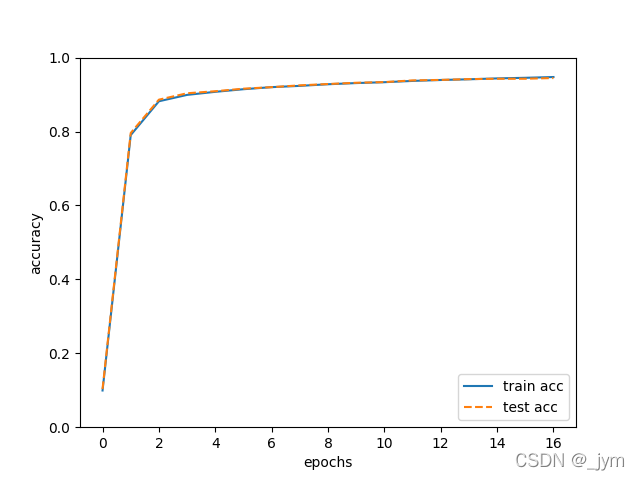机器学习 随机梯度下降法 手写数字识别
2022-04-05 14:29 jym蒟蒻 阅读(302) 评论(0) 编辑 收藏 举报基于随机梯度下降法的手写数字识别、epoch是什么、python实现
- 一、普通的随机梯度下降法的手写数字识别
- 1.1 学习流程
- 1.2 二层神经网络类
- 1.3 使用MNIST数据集进行学习
- 注:关于什么是epoch
- 二、基于误差反向传播算法求梯度的手写数字识别
- 2.1 学习流程
- 2.2 实现与结果分析
1.从训练数据中随机选择一部分数据
2.计算损失函数关于各个权重参数的梯度
这里面用数值微分方法求梯度
3.将权重参数沿梯度方向进行微小的更新
4.重复前三个步骤
params:保存神经网络参数的字典型变量
grads:保存梯度的字典型变量
def __init__(self, input_size, hidden_size, output_size, weight_init_std=0.01):
input_size:输入层神经元个数
hidden_size:隐藏层神经元个数
output_size:输出层神经元个数
def predict(self, x):
进行识别,x:图像数据
def loss(self, x, t):
求损失函数,x:图像数据;t:正确解标签
def accuracy(self, x, t):
计算识别精度
def numerical_gradient(self, x, t):
计算权重参数梯度
# coding: utf-8
import sys, os
sys.path.append(os.pardir) # 为了导入父目录的文件而进行的设定
from common.functions import *
from common.gradient import numerical_gradient
class TwoLayerNet:
def __init__(self, input_size, hidden_size, output_size, weight_init_std=0.01):
# 初始化权重
self.params = {}
self.params['W1'] = weight_init_std * np.random.randn(input_size, hidden_size)
self.params['b1'] = np.zeros(hidden_size)
self.params['W2'] = weight_init_std * np.random.randn(hidden_size, output_size)
self.params['b2'] = np.zeros(output_size)
def predict(self, x):
W1, W2 = self.params['W1'], self.params['W2']
b1, b2 = self.params['b1'], self.params['b2']
a1 = np.dot(x, W1) + b1
z1 = sigmoid(a1)
a2 = np.dot(z1, W2) + b2
y = softmax(a2)
return y
# x:输入数据, t:监督数据
def loss(self, x, t):
y = self.predict(x)
return cross_entropy_error(y, t)
def accuracy(self, x, t):
y = self.predict(x)
y = np.argmax(y, axis=1)
t = np.argmax(t, axis=1)
accuracy = np.sum(y == t) / float(x.shape[0])
return accuracy
# x:输入数据, t:监督数据
def numerical_gradient(self, x, t):
loss_W = lambda W: self.loss(x, t)
grads = {}
grads['W1'] = numerical_gradient(loss_W, self.params['W1'])
grads['b1'] = numerical_gradient(loss_W, self.params['b1'])
grads['W2'] = numerical_gradient(loss_W, self.params['W2'])
grads['b2'] = numerical_gradient(loss_W, self.params['b2'])
return grads
def numerical_gradient(f, x):
h = 1e-4 # 0.0001
grad = np.zeros_like(x)
it = np.nditer(x, flags=['multi_index'], op_flags=['readwrite'])
while not it.finished:
idx = it.multi_index
tmp_val = x[idx]
x[idx] = float(tmp_val) + h
fxh1 = f(x) # f(x+h)
x[idx] = tmp_val - h
fxh2 = f(x) # f(x-h)
grad[idx] = (fxh1 - fxh2) / (2*h)
x[idx] = tmp_val # 还原值
it.iternext()
return grad
这里面用的是数值微分方法求梯度,速度超级慢。
iters_num是梯度法的更新次数。
batch_size = 100,说明每次从60000个训练数据中随机取出100个数据。
对这100个数据求梯度,然后用梯度下降法更新参数,更新iters_num次。
最后可以画出来一个损失函数的图,的确是下降的。
什么是epoch,我们在代码里可以很清楚理解。
先来一段源码分析:
这个代码中,可看出,epochs是len(train_acc_list)。
x = np.arange(len(train_acc_list))
plt.plot(x, train_acc_list, label='train acc')
plt.xlabel("epochs")
我们看train_acc_list,它其实是在进行if i % iter_per_epoch == 0判断后,才添加的。
也就是说,每经过一个epoch,就对所有训练数据和测试数据计算识别精度。
那么就可以知道了,epoch的作用就是不那么频繁的记录识别精度,毕竟,只要从大方向上大致把握识别精度即可。
train_acc_list = []
test_acc_list = []
#平均每个epoch的重复次数
iter_per_epoch = max(train_size / batch_size, 1)
if i % iter_per_epoch == 0:
train_acc = network.accuracy(x_train, t_train)
test_acc = network.accuracy(x_test, t_test)
train_acc_list.append(train_acc)
test_acc_list.append(test_acc)
print("train acc, test acc | " + str(train_acc) + ", " + str(test_acc))
那现在就知道epoch是什么了吧,其实它就是:网络里面经过多少次数据学习之后再求整体的网络精度。
# coding: utf-8
import sys, os
sys.path.append(os.pardir) # 为了导入父目录的文件而进行的设定
import numpy as np
import matplotlib.pyplot as plt
from dataset.mnist import load_mnist
from two_layer_net import TwoLayerNet
# 读入数据
(x_train, t_train), (x_test, t_test) = load_mnist(normalize=True, one_hot_label=True)
network = TwoLayerNet(input_size=784, hidden_size=50, output_size=10)
iters_num = 10000 # 适当设定循环的次数
train_size = x_train.shape[0]
batch_size = 100
learning_rate = 0.1
train_loss_list = []
train_acc_list = []
test_acc_list = []
#平均每个epoch的重复次数
iter_per_epoch = max(train_size / batch_size, 1)
for i in range(iters_num):
batch_mask = np.random.choice(train_size, batch_size)
x_batch = x_train[batch_mask]
t_batch = t_train[batch_mask]
# 计算梯度
grad = network.numerical_gradient(x_batch, t_batch)
#grad = network.gradient(x_batch, t_batch)
# 更新参数
for key in ('W1', 'b1', 'W2', 'b2'):
network.params[key] -= learning_rate * grad[key]
loss = network.loss(x_batch, t_batch)
train_loss_list.append(loss)
#计算每个epoch的识别精度
if i % iter_per_epoch == 0:
train_acc = network.accuracy(x_train, t_train)
test_acc = network.accuracy(x_test, t_test)
train_acc_list.append(train_acc)
test_acc_list.append(test_acc)
print("train acc, test acc | " + str(train_acc) + ", " + str(test_acc))
# 绘制图形
'''
markers = {'train': 'o', 'test': 's'}
x = np.arange(len(train_acc_list))
plt.plot(x, train_acc_list, label='train acc')
plt.plot(x, test_acc_list, label='test acc', linestyle='--')
plt.xlabel("epochs")
plt.ylabel("accuracy")
plt.ylim(0, 1.0)
plt.legend(loc='lower right')
plt.show()
'''
x = np.arange(len(train_loss_list))
plt.plot(x, train_loss_list, label='train lost')
plt.xlabel("iteration")
plt.ylabel("loss")
plt.ylim(0, 3)
plt.show()
1.从训练数据中随机选择一部分数据
2.计算损失函数关于各个权重参数的梯度
这里面用误差反向传播算法求梯度
3.将权重参数沿梯度方向进行微小的更新
4.重复前三个步骤
和第一个类似,只不过改动了求梯度的函数
def gradient(self, x, t):
W1, W2 = self.params['W1'], self.params['W2']
b1, b2 = self.params['b1'], self.params['b2']
grads = {}
batch_num = x.shape[0]
# forward
a1 = np.dot(x, W1) + b1
z1 = sigmoid(a1)
a2 = np.dot(z1, W2) + b2
y = softmax(a2)
# backward
dy = (y - t) / batch_num
grads['W2'] = np.dot(z1.T, dy)
grads['b2'] = np.sum(dy, axis=0)
da1 = np.dot(dy, W2.T)
dz1 = sigmoid_grad(a1) * da1
grads['W1'] = np.dot(x.T, dz1)
grads['b1'] = np.sum(dz1, axis=0)
return grads
然后调用的时候调用下面这句话
grad = network.gradient(x_batch, t_batch)
最终结果:
下面这个图是随着网络对训练数据和测试数据训练次数的增加,网络识别精度的变化。

下面这个图表示,朝着梯度下将方向走10000次过程中,loss逐渐减小。





【推荐】国内首个AI IDE,深度理解中文开发场景,立即下载体验Trae
【推荐】编程新体验,更懂你的AI,立即体验豆包MarsCode编程助手
【推荐】抖音旗下AI助手豆包,你的智能百科全书,全免费不限次数
【推荐】轻量又高性能的 SSH 工具 IShell:AI 加持,快人一步
· 被坑几百块钱后,我竟然真的恢复了删除的微信聊天记录!
· 没有Manus邀请码?试试免邀请码的MGX或者开源的OpenManus吧
· 【自荐】一款简洁、开源的在线白板工具 Drawnix
· 园子的第一款AI主题卫衣上架——"HELLO! HOW CAN I ASSIST YOU TODAY
· Docker 太简单,K8s 太复杂?w7panel 让容器管理更轻松!